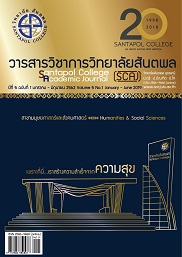อคติความสนใจ: “สิ่งที่ฉันเชื่อว่าเป็นความจริง” อคติความสนใจ: “สิ่งที่ฉันเชื่อว่าเป็นความจริง”
Main Article Content
บทคัดย่อ
อคติความสนใจเกี่ยวข้องกับการที่คนเรามีแนวโน้มที่จะให้ความสนใจกับบางสิ่งบางอย่าง แต่ในขณะเดียวกันนั้นก็จะไม่
สนใจสิ่งที่อยู่รอบตัวอื่นๆ ซึ่งผลกระทบที่เกิดขึ้นจากอคติความสนใจนี้ ไม่เพียงมีแต่สิ่งที่บุคคลรับรู้ในสภาพแวดล้อมเท่านั้น แต่ยัง
รวมไปถึงการมีอิทธิพลต่อกระบวนการตัดสินใจด้วยเช่นกัน จากการศึกษาที่ผ่านมาพบว่า มีงานวิจัยจํานวนมากที่แสดงให้เห็นถึง
ภัยคุกคามที่เกิดจากการมีอคติความสนใจ โดยเฉพาะอย่างยิ่งในผู้ที่มีความผิดปกติทางด้านอารมณ์และความวิตกกังวล ใน
บทความนี้ผู้เขียนได้ทบทวน บทความ งานวิจัยต่างๆ ที่เกี่ยวกับอคติความสนใจ โดยได้นําเสนอความหมาย แนวคิด ลักษณะเด่น
การประเมิน และวิธีการฝึกอบรมเพื่อลดอคติความสนใจเพื่อช่วยให้ผู้ที่มีความผิดปกติทางด้านอารมณ์มีการพัฒนาเกี่ยวกับ
กระบวนการรับรู้ที่นําไปสู่กระบวนการตัดสินใจที่ดียิ่งขึ้น
Article Details

อนุญาตภายใต้เงื่อนไข Creative Commons Attribution-NonCommercial-NoDerivatives 4.0 International License.
เนื้อหาและข้อมูลในบทความที่ลงตีพิมพ์ในวารสารวิชาการวิทยาลัยสันตพล ถือว่าเป็นข้อคิดเห็นและความรับผิดชอบของผู้เขียนบทความโดยตรง ซึ่งกองบรรณาธิการวารสารไม่จำเป็นต้องเห็นด้วยหรือรับผิดชอบใดๆ
เอกสารอ้างอิง
discrimination in infancy: The roles of task difficulty and expertise. Developmental Science, 13,731-737.
Bar-Haim, Y., Lamy, D., Pergamin, L., Bakermans-Kranenburg, M. J., & Van Ijzendoorn, M. H. (2007). Threat-related attentional bias in anxious and nonanxious individuals: a meta-analytic study. Psychological Bulletin, 133(1), 1-24.
Bar-Haim, Y. (2010). Research review: Attention bias modification (ABM): A novel treatment for anxiety
disorders. Journal of Child Psychology and Psychiatry, 51, 859-870.
Barlow, D. H. (2002). Anxiety and its disorders: The nature and treatment of anxiety and panic. New York:
Guilford Press.
Beck, A. T., & Bredemeier, K. (2016). A unified model of depression: Integrating clinical, cognitive, biological,
and evolutionary perspectives. Clinical Psychological Science, 4(4), 596-619.
Born, S., Kerzel, D., & Theeuwes, J. (2011). Evidence for a dissociation between the control of oculomotor
capture and disengagement. Experimental Brain Research, 208(4), 621- 631.
Carlson, J. M., & Reinke, K. S. (2008). Masked fearful faces modulate the orienting of covert spatial attention.
Emotion, 8, 522-529.
Cisler, J. M., & Koster, E. H. (2010). Mechanisms of biases towards threat in anxiety disorders: An integrative
review. Clinical Psychology Review, 30(2), 203-216.
Derakshan, N., & Koster, E. H. W. (2010). Processing efficiency in anxiety: Evidence from eye-movements
during visual search. Behaviour Research and Therapy, 48, 1180-1185.
Eysenck, M. W., & Keane, M. T. (2005). Cognitive psychology: A student's handbook. (4thedition). Taylor &
Francis.
Field, M., Munafo, M. R., & Franken, I. H. A. (2009). A meta-analytic investigation of the relationship between
attentional bias and subjective craving in substance abuse. Psychological Bulletin, 135, 589-607.
Kang, O. S., Chang, D. S., Jahng, G. H., Kim, S. Y., Kim, H., Kim, J. W., & Chae, Y. (2012). Individual differences in
smoking-related cue reactivity in smokers: an eye-tracking and fMRI study. Progress in Neuro Psychopharmacology and Biological Psychiatry, 38(2), 285-293.
Phaf, R. H., & Kan, K. J. (2007). The automaticity of emotional Stroop: A meta-analysis. Journal of Behavior
Therapy and Experimental Psychiatry, 38(2), 184-199.
Peers, P. V., & Lawrence, A. D. (2009). Attentional control of emotional distraction in rapid serial visual
presentation. Emotion, 9(1), 140.
Pool, E., Brosch, T., Delplanque, S., & Sander, D. (2014). Where is the chocolate? Rapid spatial orienting
toward stimuli associated with primary rewards. Cognition, 130(3), 348-359.
Posner, M. I., Inhoff, A. W., Friedrich, F. J., & Cohen, A. (1987). Isolating attentional systems: A cognitive-
anatomical analysis. Psychobiology, 15(2), 107-121.
Reinecke, A., Cooper, M., Favaron, E., Massey-Chase, R., & Harmer, C.(2011). Attentional bias in untreated
panic disorder. Psychiatry Research, 185, 387-393.
Sheppes, G., & Meiran, N. (2008). Divergent cognitive costs for online forms of reappraisal and istraction. Emotion, 8(6), 870.
Smith, N. K., Larsen, J. T., Chartrand, T. L., Cacioppo, J. T., Katafiasz, H. A., & Moran, K. E. (2006). Being bad
isn't always good: Affective context moderates the attention bias toward negative information. Journal of Personality and Social Psychology, 90(2), 210.
Spielberger, G. (1983). Jacobs (1983) CDTheeuwes, J., & Belopolsky, A. V. (2012). Reward grabs the eye: Oculomotor capture by rewarding stimuli.Vision Research, 74, 80-85.
Van Dillen, L. F., & Koole, S. L. (2007). Clearing the mind: a working memory model of distraction from
negative mood. Emotion, 7(4), 715-723.
Wickens, C. D., & Carswell, C. M. (2006). Handbook of human factors and ergonomics.
Weierich, M. R., Treat, T. A., & Hollingworth, A. (2008). Theories and measurement of visual attentional
processing in anxiety. Cognition and Emotion, 22(6), 985-1018.
Yiend, J. (2010). The effects of emotion on attention: A review of attentional processing of emotional
information. Cognition and Emotion, 24(1), 3-47.


